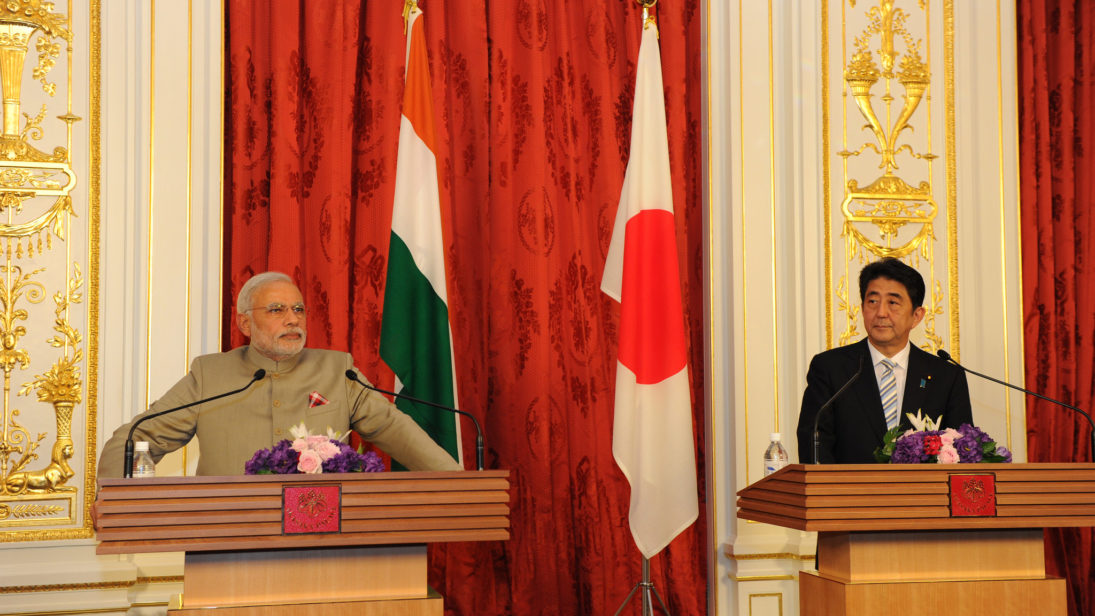
Prime Minister Narendra Modi recently visited Japan to further bolster a relationship that has become increasingly important in the last decade. However, some challenges remain.
Highlights of the Visit
India and Japan finally signed the civil nuclear Deal, which has been in the works for the past six years. The deal will enable Japan to export nuclear reactors and technology to India. Significantly, in conjunction with the nuclear agreement, both sides also signed the “Note on Views and Understanding,” in which the Japanese delegation referenced India’s 2008 commitment toward a “voluntary, unilateral moratorium on nuclear testing” as the core of the agreement. For their part, Indian officials noted that this was not an additional commitment, and the language mostly aligned with prior nuclear agreements India has made with other countries.
In addition to formalizing the nuclear agreement, other issues high on the agenda were a discussion of major infrastructural projects funded by the Japanese such as the New Delhi-Mumbai Industrial Corridor, the Bengaluru-Chennai Industrial Corridor and, most importantly, the Ahmedabad-Mumbai bullet train project. Modi and his Japanese counterpart traveled from Tokyo to Kobe in the Shinkansen bullet train and also visited Kawasaki where Shinkansen trains are manufactured. This project has taken on such importance in India-Japan relations that as many as three committee meetings have taken place in 2016 alone to discuss the project, the joint statement revealed. As I have discussed previously, this project, dubbed as Modi’s pet project, is likely to be financed by the Japan International Cooperation Agency (JICA), which has agreed to provide a loan of nearly 80,000 crore which amounts to 81% of the total project cost. The terms and conditions of the loan are favorable; it would have a tenure of 50 years and an interest rate of only 0.1% . Japan’s key motivation for providing such favorable condition terms is its desire to win other Indian high-speed projects and out-compete Chinese rail project proposals in India.

India-Japan Strategic Ties and U.S. Role
Apart from the Indo-Japan nuclear deal and discussions about economic projects, both countries affirmed greater geopolitical cooperation in the Indo-Pacific region. This was reflected in the following portion of the joint statement:
“The two Prime Ministers underscored the rising importance of the Indo-Pacific region as the key driver for the prosperity of the world. They stressed the core values of democracy, peace, the rule of law, tolerance, and respect for the environment in realizing pluralistic and inclusive growth of the region.”
Abe recognized the convergence of India’s Act East policy with this vision, and discussed with Modi his “Free and Open Indo-Pacific Strategy.” The two leaders agreed on “deeper bilateral cooperation and synergy” with regard to this issue.
However, in this context, it is also important to consider the role that the United States has played in fostering this relationship between India and Japan, such as through the trilateral MALABAR exercises, and how this role will change with the recent election of Donald J. Trump as President of the United States. For example, while the Obama administration made the pivot to Asia as a focal point of its foreign policy and spoke about a greater role for India in the Indo-Pacific region, President-elect Trump thus far has spoken about a less interventionist role in the Asia-Pacific. If Trump were to follow such an approach, it would surely impact the Japan-India strategic partnership. However, it is unclear whether a revision in Washington’s approach towards the Asia-Pacific would weaken or strengthen the cooperation between India and Japan. A reference to a deepened trilateral dialogue between India, Japan, and Australia in the joint statement could hint that partnerships in the Asia-Pacific are far more than simply a function of American policy. However, it is important not to take speculation too far because President Trump’s foreign policy, including his approach towards Asia, may witness significant revision once he takes over as president.
Conclusion
In the past decade, the Japan-India partnership has clearly witnessed an upswing in the economic and strategic sphere. Both countries are watching whether the strong American support for India and Japan would change under the incoming Trump administration. This is especially of concern considering the growing economic and military power of China in the Asia-Pacific, which makes Washington’s support for the Tokyo-New Delhi partnership extremely important. Some other concerns to note when considering closer ties between India and Japan include whether both countries’ bureaucracies will deliver on the implementation of existing deals, how both countries will handle divergences on nuclear issues, and how both countries will address their individual relationships with China, with which both have robust economic ties.
***
Image 1: MEA Photogallery, Flickr
Image 2: US-India-Japan Malabar Exercise 2015 (Stephane Belcher, U.S. Navy)


